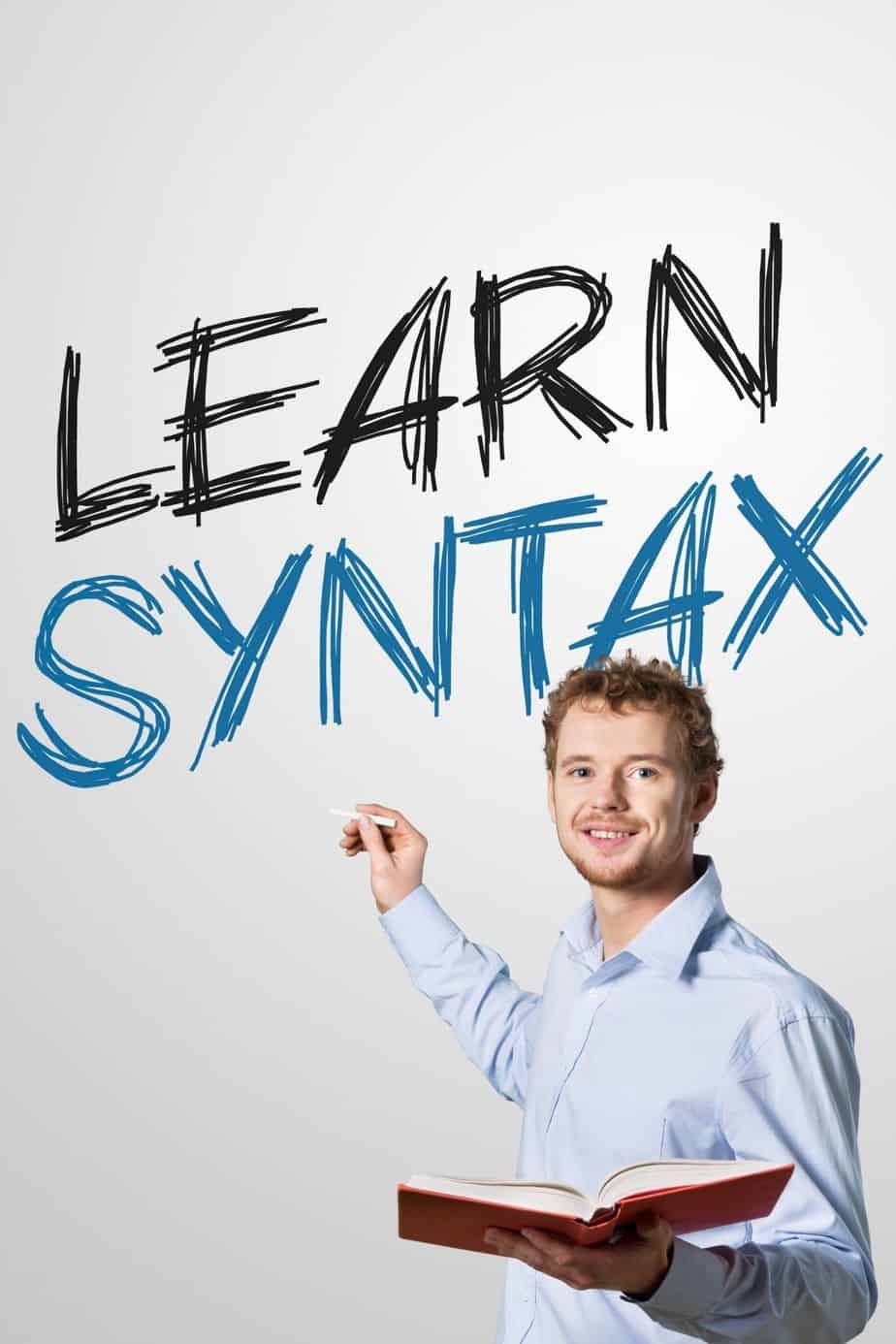Ever heard of the word “syntax” and got intimidated by it? Well, worry no more because you have certainly reached the right site to seek decent answers.
Our post today discusses the nuances of syntax in utmost detail yet in an utterly easy-to-understand way.
Why don’t we begin with a quick answer?
What is syntax?
Syntax is the study of how words are organized to form meaningful phrases and clauses. It may also be regarded as the “architecture of language” as it mainly deals with its structural aspects. “Syntax” comes from the Greek words “sun-” and “tassein” which mean “together” and “to arrange.”
Defining syntax in ample detail

For starters, “syntax” can be simply defined as the “architecture of language” because it is the school of thought that deals with how a language is constructed in detail.
The word “syntax” is of Greek origin that has been passed on to modern-day English through the Late Latin and French languages.
Having its roots in the words “sun-” and “tassein” which mean “together” and “to arrange,” respectively, “syntax” denotes practically the same meaning as its root words.
More particularly, syntax deals with how humans construct grammatically well-formed sentences and use them systematically rather than sporadically.
To put it more simply, syntax is the study of how words are arranged as well as how they relate to each other to form grammatical and meaningful sentences.
We can further understand syntax through how English questions are specifically structured to be understood by people to prompt reasonable responses.
One standard way of asking a question in English is by starting with question words, such as who, what, and why, followed by a verb, and then a subject.
This means that in English we ask questions like “Who are you?” and “Why are you here?” and not “You who are?” nor “Here why you are?”
As you can see, the syntax of a language is responsible for providing a logical way of how we make use of it, and this is hypercritical in teaching practices.
Furthermore, syntax also addresses the inquiry on how words are formed into phrases and how phrases ought to combine to form longer structures of ideas called clauses.
For example, the word “box” will become more meaningful, and hence more useful, when other words are attached to it just like when we say “in the box.”
Moreover, “in the box” will definitely make more sense when it becomes a part of a larger chunk of an idea or a “clause” as in “The doll is in the box.”
In a nutshell, being able to understand the syntax of a language is vital because it is logical and, therefore, irrefutable in most cases.
Evidently enough, languages become more teachable and comprehensible when there are certain “rules” to refer to and follow.
However, we must also bear in mind that syntax is only one aspect that makes up a language because many other facets simultaneously guide how humans make use of languages.
The other facets include the sound or phonology of the language, word meanings or semantics, context or pragmatics, other socio-cultural influences, and so on.
But, we can never undermine the value of learning and teaching syntax because, once again, it could be regarded as the least subjective aspect among others.
The importance of syntax: Understanding its value
The rise and spread of English as a global language have massively transformed communication between and among nations.
This event has also improved and broadened studies related to language structures, or as we may know by now, their syntax.
Albeit by and large not the most attractive lesson to take nor the most interesting topic to discuss, the constructs and principles under syntax are utterly critical in language preservation.
As you may already figure, languages are inherently ambiguous, dynamic, whimsical, and volatile entities that are central in all human interactions.
Without the effort and dedication of the earliest grammarians like Thrax, Panini, and Yaska, to name a few, we would not have been able to understand what living in ancient days was like.
It would be difficult, perhaps even impossible, to make sense of past and present events if we cannot understand how languages work.
Similarly, we wouldn’t have been able to make sense of other existing languages and cultures if no syntactic approaches were taken by researchers and teachers alike.
If you have heard of concepts like parts of speech, subject-verb agreement, and passivization before, these are actually all part of syntactic studies.
As you may have been wondering, it would be utterly strange and even futile to attempt to study the syntax of your own language because you already know how to use it by heart.
You would think differently when you try to formally learn another language or two because you would instead be grateful for the existing “rules” that you can simply follow.
This simply means that the generalized rules and principles under syntax are responsible for making other existing languages more accessible and learnable.
So, what are some of the basic concepts and rules under syntax? Let’s find them out in the next section.
Basic concepts under syntax

Three of the basic concepts that we need to learn under syntax are its syntactic categories, word order, and phrase structure rules.
Here are these concepts in detail:
Syntactic categories
The syntactic categories include the parts of speech that interact to form phrases and clauses; they are further subdivided into content and function words.
Content words are open-class words that bear meaning that can be easily represented or imagined; they are what we otherwise know as nouns, verbs, adjectives, and adverbs.
When words are referred to as an open-class type, they can be easily expanded and transformed into other lexical categories.
For example, the verb “to believe” is an open-class type because it can be transformed into “belief” to create a noun, “believable” to create an adjective, and “believably” to form an adverb.
Meanwhile, function words are closed-class words that do not necessarily bear meaning because their job is mainly to connect the content words, pretty much as bolts and screws do.
Trouble in recognizing to which specific category a word belongs is a common concern among natives and non-natives alike because of the technicality this process entails.
You can simply think of how people sometimes confuse the word “for” as an adverb even when it is in fact both a preposition and a conjunction.
Unlike open-class words, the closed-class type of words has minimal to no chances of growing or expanding into other lexical and non-lexical categories.
Other examples of function word categories include determiners, articles, auxiliary verbs, and pronouns.
Phrase structure rules
The phrase structure rules are a set of grammatical rules that can be used to break down and rewrite a language’s sentences into smaller, more detailed parts.
The basic parts of a sentence are composed of the noun phrase and the verb phrase; these concepts are also discussed under the phrase structure rules.
In English, well-formed sentences can be generally subdivided into two parts which are the noun phrase and the verb phrase.
To break down noun phrases and verb phrases further as well as to represent them more visually, a tree diagram is often used by linguists.
Tree diagrams help in breaking down sentences into specific syntactic categories, which then reveals how they relate to one another.
Tree diagrams are therefore used to reveal the internal structure of sentences, just like how companies use organizational charts to represent the ranks and positions of their members.
Word order
The word order concept deals with the specific and hence predictable ways as to how words are arranged to make meaningful phrases and clauses in a certain language.
In English, the basic sentence pattern is subject-verb-object or SVO, just like the Bulgarian and Macedonian languages.
This means that to make grammatical sentences in English, one needs to start with the subject, followed by the verb which can either be transitive or intransitive.
Transitive verbs are those that can work with direct objects, whereas intransitive verbs are simply the opposite.
The verb may or may not then be followed by an object, which can also be further identified either as a direct or indirect type.
The sentences below follow the subject-verb-object pattern:
Examples:
Furthermore, word order rules in English also state that adjectives generally come before nouns, just like when we say “happy people” and “imaginative ways.”
Examples:
As for adverbs, they behave more sporadically than adjectives because they can be placed in different parts of the sentence.
The most common word order rule for the different types of adverbs appearing in the same sentence is manner, place, frequency, time, and purpose.
Example:
Adverbs can also generally go either before or after the verb, albeit with some exceptions that can only be mastered as one gets immersed longer in the English language.

Basic syntactic construction rules of the English language
According to Noam Chomsky, the most celebrated linguist of modern times, languages contain certain rules and principles that can be used to create an infinite number of ideas.
This notion is known as recursion, which enables the speakers of a language to rewrite and reposition noun phrases and verb phrases in sentences.
For example, recursion can be represented by the sentence “Mark saw Joe” that can be transformed into “Lisa said that Mark saw Joe.”
The first sentence has been made part of the second sentence above, which can then be turned into “Bill said that Lisa said that Mark saw Joe,” and so on.
To further demonstrate how recursion and language transformation, listed below are some of the basic syntactic rules observed in the English language:
Pronominalization
Pronominalization is the replacement of a word or words into a pronoun, which is also composed of several more specific rules.
Please read the sentence below and focus on its subject:
Example:
As we know that the phrase “the man” particularly contains a masculine headword, we can pronominalize the same phrase to form the same idea.
Example:
Another pronominalization rule is what we use to represent the sentence “He looked at himself;” this is particularly referred to as the reflexive pronoun rule.
To understand that “himself” is referring back to the subject “he” rather than any other person, we need to know that “himself” is bound to the subject “he.”
Basically, pronominalization rules enable language users to steer clear of the repetitive usage of the same word, which is quite bothering especially in longer texts and conversations.
Question formation

Question formation is a specific case of pronominalization wherein a specific type of pronoun called relative pronouns is used to create questions.
Relative pronouns include words like “who,” “what,” “when,” “where,” “whose,” and “which”; these types of pronouns may also be used in declarative sentence forms.
Should you wish to learn more about these types of pronouns, you may also refer to our other resource material that covers the use of commas before relative pronouns in detail.
Now, kindly read the sentence below to have an initial understanding of how the process of question formation works in English:
Example:
There are several ways of creating questions directly from the given sentence above, but the most obvious ones are as follows:
Example:
As you can see, the rules on question formation are easy to teach especially to children second-language learners alike.
Tagging
Tagging is the process in which confirmatory fragments are added at the end of a declarative or imperative sentence to change its original purpose.
Tags or mini-questions are formed by reversing the verb form (i.e., positive to negative and vice versa) and pronominalizing the subject.
Please look at this sentence:
Example:
To attach a mini-question at the end of the sentence, we need to know that the subject pronoun to use for “the woman” is “she” and that the negative form of “is” is “isn’t.”
Example:
In a nutshell, the confirmatory function of tag questions is useful when we want to make use of some polite truth-checking sentence construction.
Coordination
Coordination is the process of combining two sentences into one. Coordinated sentences enable users to convey more ideas at once or shortly.
Please read the next two sentences:
Examples:
Instead of separately saying or writing the two sentences above, we can easily condense them into one sentence through coordination.
To coordinate the two sentences properly, one must know the basic subject-verb agreement rule in English wherein plural subjects need to use the auxiliary verb “are” instead of “is.”
Here’s how the sentences can be coordinated:
Example:
As you may figure, coordination rules are great for helping children and second language learners shorten repetitive ideas, which would then develop their skill in generating more ideas.
Passivization
Last but not least, we have the type of construction called passivization; this process requires a relatively higher level of language competence to be understood and executed.
The goal of passivization is to shift the focus of the sentence construction from the subject to either the action or the object in the same sentence.
Please read the next sentence:
Example:
To be able to form passive sentences, we must still adhere to the subject-verb-object word order or pattern.
However, this time, we have to move the object to the subject position to obtain the topic shift described earlier.
In addition, we also need to know that the verb needs to be structured in simple past auxiliary-past participle format to achieve the desired result.
Here’s how we can passivize the example sentence earlier:
Example:
Clearly enough, passivization is especially crucial in forming sentences when we do not know who or what exactly the agent is.
This syntactic rule is extremely vital in writing news reports, for example, when the journalist does not know who the suspect of a crime is at the time of writing.
Frequently Asked Questions on “What is Syntax?”
What is “syntax” in programming?
“Syntax” in programming is similar to the notion of syntax in linguistics. “Syntax” is the study of the rules that govern the grammatical and orthographic (spelling) rules of a language. Computing systems are commanded by languages, hence the convergence of the two fields.
Why is syntax important in linguistics?
Syntax is essential in the field of linguistics because it provides a systematic and logical way of explaining the structure of languages, as well as how linguistic elements interact together to form meaningful thought representations.
What is an example of “syntax”?
The sentence “Colorless green ideas sleep furiously” by Chomsky is one of the best examples that capture the essence of syntax. It follows the correct syntax of the English language, yet it is meanwhile meaningless. Hence, syntactically correct yet semantically empty constructions are useless.
Conclusion
Abstract concepts like syntax are generally not introduced to young learners. Nevertheless, we can not undermine their importance in increasing our knowledge about the world.
Hope that this is the key takeaway you’ve had upon reading the end of today’s post. Until next time!

Hey fellow Linguaholics! It’s me, Marcel. I am the proud owner of linguaholic.com. Languages have always been my passion and I have studied Linguistics, Computational Linguistics and Sinology at the University of Zurich. It is my utmost pleasure to share with all of you guys what I know about languages and linguistics in general.

